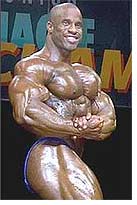Proven techniques to Build Muscle Mass
By Shawn LeBrun, author of "Simple Steps To Get Huge and Shredded"
and "7 Things You MUST DO To Gain Weight"
 If you want to build muscle mass, you first need to understand what causes a muscle to grow and become stronger. There is one and only one reason a muscle has for getting bigger and stronger.
If you want to build muscle mass, you first need to understand what causes a muscle to grow and become stronger. There is one and only one reason a muscle has for getting bigger and stronger.
Progressively increased overload
I will repeat this statement again because you will not build muscle mass if you don't follow this rule.
The only reason a muscle will get bigger and become stronger is by increasing the amount of overload, or "work" on that muscle. A muscle responds to stress (weight training) by adapting and growing to handle the future stress that will be placed upon it.
Continue to train a muscle with the same weight and you will get the same results. You need to progressively "force" the muscle into growing stronger or you will not build muscle mass. So in order to increase overload, you need to increase resistance. In order to increase resistance, you need to increase the amount of weight, or work, you are doing.
Lower repetitions of an exercise will allow you to increase the overload to that muscle instantaneously. This forces the stimulation of new muscle fibers that will be recruited to handle the additional stresses that will be placed upon the muscle.
The optimal repetition range to build muscle mass will be between four and six repetitions for just about every exercise you do.
Now, contradictory to myths I’ve heard, this low repetition range will not increase the likelihood of injury. If anything, it will reduce the chance of injury because your muscles are becoming accustomed to handling additional forces not normally subjected upon them, therefore strengthening them.
Low reps will not cause you to "bulk" up unwontedly. Low reps will strengthen and "tone" your muscles quicker than higher reps. Lighter weights and higher reps will basically keep you from making optimal gains. It is easier to train more intensely if you are focusing on only four to six repetitions instead of ten to fifteen. If you can do ten repetitions of an exercise, the weight is too light to achieve overload.
If you are new to an exercise and are just learning how to do an exercise, ten repetitions are fine.
How do you know what weight to use? The first week or two of your routine will be more or less a trial and error period. You will quickly learn which weight you should be using. If you can do more than six repetitions on your heavy sets for an exercise, the weight is too light. If you cannot do at least four, the weight is too heavy. That is how you tell.
When you are doing more than six repetitions with ease, time to move the weight, or "work" up to the next level. Depending on which exercise you are dong, this could range from one pound on the arm curls to five pounds on the bench press. Here is where the progressive overload occurs and it's how you build muscle mass. Remember, in order for a muscle to respond by growing, it needs to be forced.
Here is where efficiency also comes into play. Four to six reps, if performed with extreme intensity, will be more effective than ten reps of lighter weight and less intensity. That is efficiency.
The amount of heavy, intense sets per exercise will either be one set or two sets, depending on the order of the exercise.
We will discuss warming up correctly more in depth in a later chapter, but I will briefly discuss it now. When doing an exercise, you only want to warm-up just enough so that the blood flow has increased in the muscles and you feel ready to increase the amount of work you are going to do. You never want to warm-up to the point of tiring the muscles before you get to your heavy sets.
When you are warmed up, the number of all-out, intense sets will be two at the most, and on some exercises, just one set. Remember quality over quantity. It is the overload that helps you build muscle mass, not the amount of sets you do. There is no "universal law" which states that if you double the amount of reps you perform, you also double the results.
The key is to shock the muscle into responding and growing. You do this with two, very intense sets of four to six repetitions. This will efficiently stimulate the muscles more than doing more sets with more reps at a lighter weight. As a result, you'll build muscle mass.
Your heavy, intense set is the set that you do at least four reps, but not more than six. Again, if you can do more than six reps, increase the weight. If you can’t get a good four, lower the amount of weight. This is very important. You want to "hit failure" between this range. If we were doing the flat bench press, we would do our warm-ups and then two heavy, intense sets of four to six repetitions. This exercise is now done. You have effectively overloaded the chest muscles and will then proceed to the next exercise.
Using this lower rep range is the best thing you can do to build muscle mass.
Click here to discover the best program online to build muscle mass in less time...
Shawn LeBrun is a certified personal trainer, online fitness expert and author of "Simple Steps To Get Huge and Shredded" and "7 Things You MUST DO To Gain Weight"



